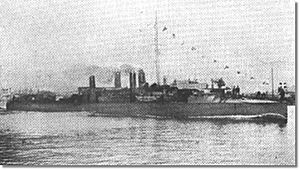Greek destroyer Lonchi (1907) facts for kids

Lonchi - Α/Τ Λόγχη
|
|
Quick facts for kids History |
|
|---|---|
| Name | Lonchi |
| Namesake | Spear |
| Ordered | 1905 |
| Builder | Yarrow Shipbuilders, Cubitt Town, London |
| Laid down | 1905 |
| Launched | July 7, 1907 |
| Commissioned | 1907 |
| Decommissioned | 1926 |
| Fate | Broken up in 1931 |
| General characteristics | |
| Class and type | Thyella class destroyer |
| Displacement | Standard 350 long tons (360 t) |
| Length | 67.1 m (220 ft) |
| Beam | 6.2 m (20 ft) |
| Draft | 1.8 m (5 ft 11 in) |
| Propulsion | 2 shafts, 6,000 hp (4,500 kW) |
| Speed | 30-knot (56 km/h) maximum |
| Complement | 70 |
| Armament |
|
The Lonchi (which means "Spear" in Greek) was a type of warship called a destroyer. It belonged to the Thyella class of destroyers. This ship served in the Royal Hellenic Navy starting in 1907.
Lonchi and its three sister ships were ordered from England in 1906. They were built at the Yarrow shipyard in Cubitt Town, London. The Lonchi was about 220 feet (67 m) long. It weighed about 352 metric tons (346 long tons; 388 short tons) and carried powerful weapons. These included two 18 in (46 cm) torpedo tubes, two 76 mm (3.0 in) guns, and two 57 mm (2.2 in) guns.
This ship was very active during several important conflicts. It played a role in the Balkan Wars, World War I, and the Greco-Turkish War (1919–1922). After many years of service, Lonchi was taken out of the navy in 1926 and later taken apart for scrap in 1931.
Contents
Building the Lonchi Destroyer
The Lonchi was ordered from the Yarrow shipyard in Cubitt Town, London, in 1905. Three other ships, the Thyella, Nafkratousa, and Sfendoni, were ordered at the same time.
Lonchi was officially launched into the water on July 10, 1907. The ship was about 220 feet (67 m) long. It was 20 ft 6 in (6.25 m) wide and had a depth of 6 ft (1.8 m) in the water. When it was empty, Lonchi weighed about 352 metric tons (346 long tons; 388 short tons). When fully loaded for battle, its weight increased to 380 t (370 long tons; 420 short tons).
The ship was powered by two large engines. These engines used steam from four special boilers that burned coal. The engines were designed to produce 6,000 indicated horsepower (4,500 kW) of power. This allowed the ship to reach a top speed of 30 knots (56 km/h; 35 mph). During tests, the ships actually went even faster, between 31.8 to 32.4 kn (58.9 to 60.0 km/h; 36.6 to 37.3 mph).
Lonchi was equipped with several types of weapons. Its main attack weapons were two 18 in (46 cm) torpedo tubes. These tubes could turn and were placed on the back of the ship. It also had smaller guns for defense. These included two 76 mm (3.0 in) Hotchkiss guns and two 57 mm (2.2 in) Hotchkiss guns.
Lonchi's Service History
The Lonchi played an important role in several wars. Its first major conflict was the First Balkan War, which began in October 1912. This war was fought between the Ottoman Empire and countries like Greece, Serbia, and Bulgaria.
Role in the Balkan Wars
The Greek Navy quickly took control of the Aegean Sea. On October 19, 1912, the main Greek fleet set sail from Piraeus. This fleet included the powerful armored cruiser Georgios Averof and fourteen destroyers, including Lonchi.
The fleet landed troops at Mudros Bay. By the next day, the island was under Greek control. After this, the navy launched attacks on other islands in the Aegean Sea. They captured Thasos, Samothrace, Imbros, and Tenedos very quickly. After securing these islands, the Greek Navy set up a blockade of the Dardanelles. This blockade kept the Ottoman Navy trapped for the rest of the war.
Service During World War I
When World War I started in 1914, Greece's king, Constantine I, decided that Greece would remain neutral. However, the Triple Entente powers (like France and Britain) landed troops in Salonika in 1915. This caused problems between France and Greece.
Because of these tensions, the French took control of the Greek Navy on October 19, 1916. The Greek light ships, including Lonchi, then served in the French Navy. They flew the French flag. King Constantine I was later forced to step down. His son, Alexander of Greece, became king and agreed to join the Entente. Greece declared war on the Central Powers on July 2, 1917. Even so, Lonchi continued to serve with the French Navy through 1918. By 1918, the ship was back under Greek control. It mainly helped escort other ships in the Aegean Sea.
Later Years and Retirement
After World War I ended and the Ottoman Empire was defeated, Greece tried to take control of Ottoman lands in the Aegean and Asia Minor. The entire Greek Navy, including Lonchi, was very busy during this time. They patrolled the eastern Mediterranean Sea and supported land operations.
These operations ended in September 1922. The Greek Army had to leave Asia Minor by sea, taking many civilians with them. The fleet helped transport a total of 250,000 soldiers and civilians during this large evacuation.
By 1926, the Lonchi was in poor condition. It was removed from the naval list. The ship was finally taken apart for scrap metal in 1931.
Images for kids


